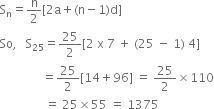Show that a1 , a2 , . . ., an, . . . form an AP where an is defined as below :
an = 3 + 4n
It is given that,
an = 3 + 4n
So, a1 = 3 + 4(1) = 3 + 4 = 7
a2 = 3 + 4 (2) = 3 + 8 = 11
and a3 = 3 + 4(3) = 3 + 12 = 15
Now, er have following numbers :
7, 11, 15, ...........
Since the difference between each pair of consecutive terms are constant
So, the given number forms an A. P.
Here, a = 7, d = 4, n = 15
We know that, 



